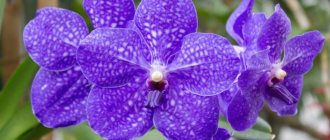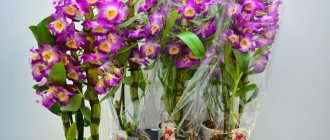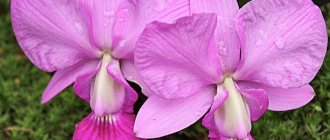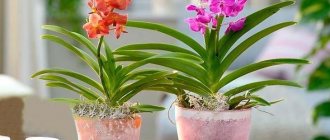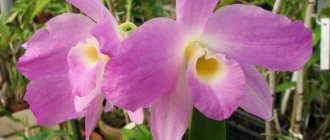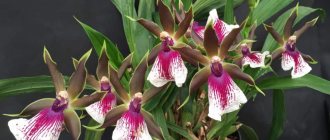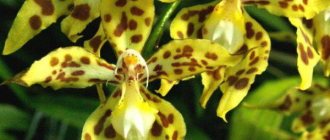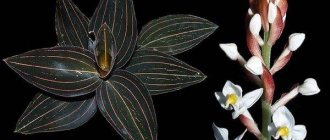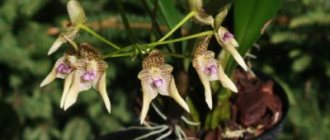This variety of orchid goes back to the 18th century in Asian countries. That's where she comes from.
In addition to its beautiful flowers, this orchid is unique for its root system : unlike other varieties, its roots are more powerful, they can receive moisture even from the atmosphere. Therefore, the Vanda orchid is not threatened by prolonged droughts and possible burns. However, this variety is quite whimsical and will require great care during care . One slight mistake and the plant may die. Next we will tell you how to care for the beautiful Wanda.
Conditions of detention
Since this variety comes from hot latitudes, the maintenance conditions must be appropriate:
- the air temperature should be between 16-29 degrees; if the room is more than 30 degrees, the plant may die;
- humidity should be within 80% (this figure can be maintained by regularly spraying the plant);
- Vanda does not require any substrate ; its root system must be constantly open. As a last resort, you can use oak bark as in the case of Phalaenopsis;
- This plant is very light-loving , but it is worth limiting direct sunlight. It is especially important to maintain proper lighting in winter; in summer, the orchid can be placed on the balcony;
- When planting in the ground, water the plant, just like other varieties of orchids: as the substrate dries.
Vanda's root system can be left open.
Important! The temperature to maintain this flower should be the same throughout the year.
Vanda does not have periods of rest or active growth . Only during flowering can the growth of its leaves stop. Strong changes in temperature can provoke a lot of diseases for the flower. It is best to keep Vanda open (without adding soil).
How to care?
For normal growth and development, they create special conditions for Vanda and take proper care of her.
Temperature and humidity
Vanda is a plant that loves warmth. When grown on a windowsill in an apartment, the temperature during the day is maintained between +18 and +30 and at night around +16 degrees Celsius. The normal level of humidity in a room is from 70 to 90%.
Ventilation stimulates flowering if the temperature difference between day and night is about 10°C. Spraying is carried out only during the day. In this case, water is used whose temperature is 6°C higher than the air temperature.
Lighting
Vanda is a sun-loving flower, but she is afraid of direct sunlight. The lighting for it should be diffused but bright. Leaving it on the windowsill and not shading it from the sun will prevent burns on the leaves. When there is not enough light, Vanda does not bloom.
In summer, the pot with the plant is placed on the balcony/loggia. At first they put him in a less lit place, but gradually accustom him to sunlight.
The size and color of the leaf plate determine whether the vande has enough light or not:
- if the leaves are green, then everything is fine;
- if they are dark, then there is not enough light;
- if they are light green or yellowish in color, there is a lot of light;
- if the penultimate pair of leaves is shorter than the last, add additional light to the orchid;
- if the last pair of leaves is shorter, then the lighting was too much.
Watering
For good life and growth of the vanda orchid, you need to alternate dry and wet cycles. In summer it is watered daily, and in winter - three times a week before lunch. Water should not stagnate near the roots.
Flower growers water the orchid using one of the methods listed below.
- Hot shower. Vanda is taken to the bathroom, where it is watered with warm water from the shower until the color of the roots changes to green. Then turn off the water and leave it in the bathroom until the pot dries. After an hour, wipe the leaves with a cloth slightly moistened with water.
- Immersion. If the plant is healthy, place it in a bowl of water for half a minute. Then they take it out of it, wait the same amount of time and take it to the windowsill.
- Watering can. Water is poured from a watering can along the edge of the pot. As soon as the liquid begins to overflow, stop watering. When all the excess water has drained, water the orchid again.
- Spraying. If the vanda has bare roots, avoid immersion or watering from a watering can.
Top dressing
The plant is fed by moistening it with a spray bottle or soaking it in water, the temperature of which is 5-6 degrees higher than the air temperature. In winter, the procedure is carried out in the morning, and in summer at noon.
Mineral fertilizers are applied once a month. Take 10 liters of water and dissolve 13 g of ready-made fertilizer in it. After thorough mixing, pour the resulting liquid over the orchid.
Fertilizers are not applied uncontrollably, otherwise it loses its visual appeal, becomes sluggish, and its upper part becomes soft. They also look at young leaves. They have a pale green stripe, the thickness of which should normally be 1 centimeter. If it is narrower, then there is not enough fertilizer, and if it is wider, then there is too much fertilizer.
Planting and transplanting
Planting and caring for Vanda has its own characteristics:
- No soil is required for planting it. Very often, orchid lovers simply hang the plant on the wall and leave its root system open;
- for less experienced gardeners, it is allowed to use a small amount of substrate in the form of oak bark;
- You can also use a plastic container with a lot of holes in it. The entire root system of the orchid is placed in it, and thanks to the holes, a sufficient amount of moisture, light and air enters it.
This variety of orchid does not need to be replanted. Wanda doesn’t like changing the pot, so having bought an orchid in a small plastic pot at the store, it’s better not to disturb it for a while with replantings. Today, many orchid lovers prefer to grow Vanda in large glass pots. We'll talk about this a little later.
Advice! When using a substrate, it must be changed at least once every 6 months.
Orchid propagation and care of young plants
You can get new orchid plants by planting daughter rosettes from the mother specimen, which form at the base of the adult flower.
Young plants should be separated from a large bush only when their own roots have formed. During vegetative propagation and care of orchids, all sections must be treated with cinnamon powder or crushed activated carbon. First, the rosettes are planted in shallow baskets with a mixture of charcoal, pieces of bark and sphagnum and the containers are placed in the greenhouse. There, young Vanda grow and actively form roots until the height of the stem reaches 15–18 cm. Now the plant is ready to decorate the room with lush inflorescences.
Vanda Orchid: home care
Since this variety of orchids is mainly grown without the use of a substrate, watering must be done as follows: the entire root system is carefully placed in a container of water and kept there for about 20-30 minutes. After that, take it out and let it drain a little. It is very important not to wet the stems and leaves when watering.
You need to water the plant:
- in summer, once every 4 days;
- in winter no more than once a week.
If a substrate is used when growing Vanda, then the frequency of watering should be reduced to once a week in the summer and once every 14 days in the winter. More frequent watering leads to rotting of the root system and death of the plant.
For watering, the roots of the plant are completely immersed in water.
Important! To increase the humidity level, it is allowed to spray the orchid once every 7 days in winter and 2 times a week in summer. In this case, you need to make sure that water does not get on the stems, leaves and flowers.
When using a glass container, watering is carried out as follows: carefully pour clean water into the vase in a small stream so that the roots are immersed in it. Let it sit for about half an hour, then drain it thoroughly.
This procedure is carried out twice a week in summer and once in winter . When using glass vases, watering must be done very carefully to prevent rotting of the root system (this can occur due to limited air access).
Complementary feeding is carried out during the period of Vanda's vegetative growth . Use special fertilizers with the addition of potassium monophosphate. Take based on the proportion of 1 g of fertilizer per 1000 ml of water. Fertilize, as a rule, once a month. It is important to note that complementary feeding is best introduced after Vanda has finished flowering.
As mentioned above, this variety of orchids does not have a clearly defined period of growth and dormancy. Abundance of flowering is observed in spring and summer (this is caused by greater natural light).
The flowering period can last up to 2-3 months . If properly maintained, the Vanda orchid will delight its owner with flowering all year long.
The flowers of the plant are simply unique, they have different shapes and colors. If flowering does not occur for a long time, then you need to check whether the plant has enough color, whether there are temperature changes, or perhaps it is simply overfed with fertilizers.
After flowering has ended, it is necessary to trim dried flower stalks and reduce watering and spraying to a minimum.
Varieties
Now let's take a closer look at the most popular representatives of the Vanda orchid:
Blue Vanda (Vanda coerulea)
An epiphyte with an erect stem reaching a meter in height. The roots are numerous and well developed. The leaves are belt-shaped, dense, arranged in two rows. The length of the peduncle with a multi-flowered raceme is about half a meter, on one peduncle there are from six to twelve flowers. The flowers are fragrant, large - up to 10 cm in diameter, bluish-blue with a reticulate pattern of a darker color. The lip is smaller than other parts of the flower and more saturated in color. Gradually the color of the flower becomes lighter.
In the photo: Blue Vanda (Vanda coerulea)
Vanda tricolor
A large and tall epiphyte, the stem of which reaches a height of more than one and a half meters. Belt-shaped leathery leaves from 25 cm to 40 cm long are arranged in two rows. The inflorescence contains from 7 to 10 fragrant, star-shaped flowers up to 7 cm in diameter. Petals and sepals with a wide nail, wavy, oval, pure white or white with a cream tint, strewn with dark red spots. The lip is the same length as the petals, three-lobed, the large middle lobe is shaped like a guitar and colored ink-pink.
In the photo: Vanda tricolor
Vanda sanderiana
Also a large type of epiphyte with belt-shaped leaves up to 40 cm long. Straight apical inflorescences contain up to 10 flowers - pink with a white border and with a yellow-red lip up to 15 cm in diameter.
In the photo: Vanda sanderiana
Vanda Rothschildiana
A variety obtained by crossing Vanda blue and Vanda Sander. Its leaves are belt-shaped, its flowers, collected in a multi-flowered inflorescence, are light blue in color, 4-5 cm in diameter.
In the photo: Vanda Rothschildiana
Vanda teres
It is distinguished by a highly branched stem up to 2.5 m in height. The stem is drooping or climbing, equipped with many aerial roots. On the peduncle there are from three to six whitish-pink or reddish flowers, sometimes reaching 10 cm in diameter. The petals and sepals are diamond-shaped or oval, almost round and wavy along the edge. The middle lobe of the lip is purple, bifid and broadly wedge-shaped, the lateral lobes, yellow at the base, dotted with red specks.
In the photo: Vanda teres
Recently, orchids have become very popular in floral design. They are included in bouquets; with their help, decorators create a mysterious and exciting atmosphere of a tropical forest in the room. The hour is not far off when breeders will create new varieties of vandas, more adapted to our latitudes, which will become much easier to grow in our living conditions. In the meantime... No matter how capricious this orchid may be, the beautiful flower that has blossomed as a result of your many days of effort will reward you for your work with its beauty and fragrance, and you, frozen in admiration, will say with relief: “It was worth it.”
Reproduction
Like all other types of orchids, Vanda reproduces by transplanting its children . This phenomenon is quite rare; they can be separated from the main root system when the child’s roots reach a length of at least 5 cm . After circumcision of the baby, the place of attachment to the roots must be treated with charcoal to prevent the spread of infection.
Orchid Vanda (photo with baby).
The baby is placed in a special pot and kept in greenhouse conditions, while the air humidity should be about 90%. Tree bark and sphagnum moss (4:1) are used as a substrate. In this way, the baby is kept until it grows 20 cm in length, then it can be transplanted into a regular orchid pot and continued care as for an adult plant.
It should be noted that any other methods of transplanting this plant are prohibited . However, diligent flower growers sometimes try to propagate Vanda using seeds. This is a very long and labor-intensive process.
Features of the process, how to grow from a seed:
- seeds are grown in a nutrient medium, which is obtained under sterile laboratory conditions;
- germination duration is about 9 months;
- it takes up to 3 years to get a shoot that can be transplanted;
- Flowering of a plant grown in this way can take up to 4-10 years.
For propagation, therefore, you will need Vanda orchid seeds, moist soil (moss and deciduous soil), conditions of complete sterility, temperature within 25 degrees, humidity - 80-90%. After the first leaves appear, they need to be picked.
Brief information
Vanda's stem is straight and can reach 1 meter in length - this feature is used when growing for cutting. Narrow long leaves with a glossy surface and dense structure are arranged alternately.
The greyish-greenish roots, up to 1 m long, are special to the plant - they are covered with cells of a porous structure, which allows them to be replenished with moisture from the environment.
On straight or drooping peduncles (30-60cm), growing from the leaf axils, 2-15 flowers (up to 10cm in diameter) are formed, the color of which depends on the varietal. As the flowers grow, they significantly increase in size and acquire a more saturated color.
Flowering duration is 1.5-3 months. If you follow the rules of care, it can bloom more than once a year, since this variety does not have a period of sleep (rest).
Information! The most common types of Vanda orchids are: checkerboard, lamellar, tricolor, roller, blue.
Growing
In a glass vase
Very often I use glass containers to breed these orchids, but growing in a glass flask has its own nuances.
How to plant correctly?
To plant Vanda in such a container, you need to choose a pot that has a cone shape . The roots of the plant are carefully placed in it so that the leaves are on top of the sides .
A healthy orchid has bright green leaves and stems and blooms profusely. The roots are not dried and have a natural color.
Correct position in the vase.
When growing in glass, the use of any substrate is not required . Watering should be carried out no more than once a week in winter and 2 times a week in summer. More frequent moistening can lead to rotting of the root system and death of the orchid.
It is necessary to monitor the lighting , as glass prevents the penetration of sunlight.
Possible problems
Vanda is a very whimsical plant, so its owner needs to have a lot of patience and then the flower will definitely thank you. If your orchid leaves turn yellow, you need to check:
- temperature in the room;
- is there an unpleasant neighborhood?
- humidity and lighting levels;
- overfeeding with fertilizers.
Sometimes the plant is prone to naturally dropping leaves. Root rot can be caused by excess moisture, so it is worth reducing the amount of watering.
The dropping of flowers and buds can occur due to overheating of the orchid. In this case, it is imperative to monitor the temperature in the room where Wanda is kept.
Reanimation of a plant with no roots
This can be accomplished by growing new roots from the neck of the plant. Technology on how to revive such a Wanda:
- you need to take ordinary boiled water and a section of the orchid;
- it is placed in a vessel so that the leaves remain on top;
- they are placed in a kind of greenhouse, where the temperature is maintained at 25 degrees around the clock;
- As the liquid evaporates, it must be added.
After just a few months, you can see fresh roots and replant the orchid.
The orchid is reanimated by placing it in water.
Diseases, their treatment and prevention
Important! Like other types of orchids, Vanda is susceptible to many diseases: burns, fungal infections, bacterial rot.
For prevention, you need to carefully monitor temperature and humidity , and treat the plant with fungicidal preparations. If rot is detected, you need to treat the orchid with an antibiotic solution.
To prevent the proliferation of pests, you can treat Vanda with an alcohol-soap solution.
Diseases and other problems of Wanda
Even with normal care of any flower, some problems are possible. If the rules of care are often violated, then diseases and other problems cannot be avoided. Let's look at their causes and solutions in more detail.
- Fusarium. This fungal disease appears as dark spots at the base of the leaves and on the stem of the plant. The reason is lack of light and improper watering. Treat with fungicides, for example, Fundazol, according to the instructions. Remove affected leaves and dead roots promptly. Treat the cuts with charcoal powder or brilliant green.
- Bacterial, gray rot and viruses attack this plant in the warm season. Remove infected parts of the flower immediately. Treat with fungicides (ask at special flower shops).
- Rotting of the stem, leaves and roots is caused by excess moisture. To correct the situation, remove the plant from the pot, remove the damaged parts, treat healthy parts and roots with a solution of “Zircon” or succinic acid, then plant in a new substrate.
- Falling buds. There are many reasons: insufficient humidity; lack of lighting; there is no difference between night and day temperatures; low room temperature; the flower was overfed with nitrogen; on the contrary, they forgot to feed it on time. Correct mistakes and wait for the next flowering.
- Yellowing of the leaves is a consequence of insufficient watering. Do not skip the timing of watering, immersion and spraying.
- Yellow-brown spots on the leaves are signs of sunburn. The orchid needs to be shaded at midday from the sun's rays.
- The leaves and peduncle of Vanda have drooped. The reason is poor lighting. Move to a brighter place or organize an additional light source.
- The peduncle turns brown and dies. The cause may be insect pests. Remove the peduncle and start fighting the insects.
Pests
It is quite rare to find pests sucking on Wanda, but you need to get to know them. This could be spider mites, mealybugs, aphids, thrips or scale insects. Bathing under a warm shower in the bathroom will help in the fight against them at the initial stage. Some, for example, scale insects, can be successfully removed from the leaves using a napkin moistened with alcohol. But, if the damage is severe, you will have to fight it with chemicals (fungicides). We advise you to take a photo of your insects on your phone and go to the store. There, the seller will select a suitable product for you based on the photo and tell you how to use it.

